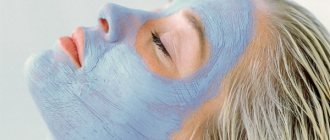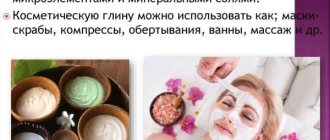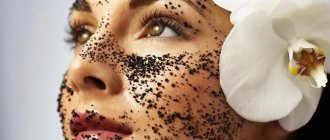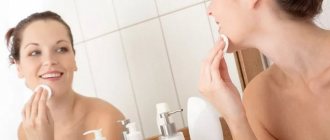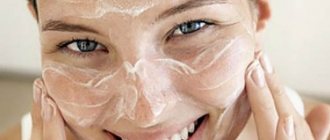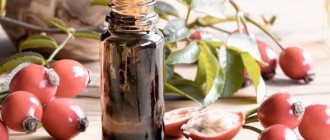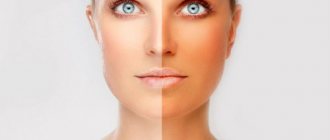Cosmetic clay as a cosmetic product has been known to the world for quite a long time. It is known to have antibacterial, anti-inflammatory and detox properties. In this article we will tell you about cosmetic clay: how to use, basic properties, composition, and so on.
On the shelves of ordinary stores it is very easy to find cosmetic clay of any color, either as a mono product or as one of the components in cosmetics. Depending on the color of the clay, its properties differ, but we will talk about this below.
What's happened
Green clay is small pieces of rock. Formed under the influence of natural phenomena. Known for a long time. The green sedimentary mass is also called French, illite. First opened in Brittany (France). It is mined from a depth of up to 15 m. Silver and iron oxide give a unique color. In cosmetology it is used for hair and face.
The traditional form of release is powder. They are bred, making it plastic. Masks are made from mountain deposits. To fight cellulite, they do body wraps. Taken orally. The spicy scent of green clay is used in aromatherapy.
Compound
Green clay is nature’s most valuable gift to man.
Its deposits are located at great depths. The high-quality product is mined on the northern coast of Brittany in France - the most environmentally friendly area in Europe. For cosmetic purposes, clay removed from the formation at a depth of 10-15 meters is used. The time of formation of the deposits dates back to the post-glacial period; this factor ensures the purity of the substance from harmful impurities resulting from human pollution of the environment. Compared to other varieties, green clay contains the largest amount of substances necessary for the human body:
- magnesium;
- calcium;
- silver;
- manganese;
- phosphorus;
- iron and aluminum oxides;
- zinc;
- copper;
- cobalt;
- silicon;
- molybdenum.
Being on the seabed, the green clay was enriched over many centuries with the most valuable minerals contained in the water. To obtain a powdered cosmetic product, it undergoes long-term delicate cleaning and drying in the sun.
Cosmetic clay - types
The colors of clay are created by the presence of mineral elements. Hence the usefulness of certain shades. Let's look at what kind of clay there is.
Blue
Microelements - calcium, aluminum, sodium, zinc, manganese, iron, silicon. Has a grayish tint. Bright blue indicates artificial enrichment with substances.
Pink
There is no such thing as natural. It is obtained by proportionally combining red and white clay. Includes - Mg, Fe, Ca, Cu, Si, Zn, silica. Should be practiced if you have increased sensitivity. Restores, moisturizes, softens.
Yellow
The yellow color is formed by iron and potassium. Used for rejuvenation. Saturates tissues with oxygen and moisture. Suitable for excess fat content. Exfoliating effect.
White
Recognized in facial cosmetics. Contains zinc, aluminum, silica, silicon, manganese, calcium. Used for problem skin, detox functions, turgor, tone. Whitens, smooths out age spots, scars. Used for cellulite and stretch marks.
Red
Country of origin: Morocco. Extracted from a volcano. Ingredients: ferrum, magnesium, copper, silicium (Si). The color range ranges from grayish to purple. Effective for problematic dermis. Anti-aging. The result is toning, lifting, regeneration. Complements shampoo - combats dry, dull hair, dandruff. Increases blood flow in case of cellulite.
Black
Made from volcanic rock. Ingredients: Quartz, Fe, Carbon, Magnesium, Ca. Clears away toxins. Nourishes hair. Helps tighten while losing weight.
Gray
The characteristics are similar to black. Perfect for dry skin types. Protects from harmful environment. Cosmetologists suggest adding it to baths for hands and feet. Antimicrobial protection, cleansing.
Green
The green clay discussed in this review is the most effective of those listed above. Rarely found in nature. Base - silver, copper, Fe, potassium, zinc, Si, Al. Gently cleanses and exfoliates. Complex effect on the epidermis. Let's study it in more detail below.
Beneficial features
Positive Actions:
Removes old, dysfunctional cells. Removes irritation and peeling.
Absorbs excess sebum and sweat. Gently cleans the surface.
Increases tone.
Compresses and cleanses pores.
Balances the sebaceous glands.
Normalizes the hydro composition of the dermis.
Powerful anti-aging results. Lifting effect, tone alignment.
Activates blood circulation. Nourishes cells.
Anti-inflammatory.
Increases immunity, protecting against harmful environmental influences.
Suitable for all derma types. Helps oily people as much as possible.
Indications
Green clay is my favorite skincare product. It helps to correct many shortcomings using the powers of the earth contained in it. The composition is completely non-aggressive towards the skin, acts softly and delicately.
I recommend green clay to my clients if they have:
- increased secretion of the sebaceous glands;
- acne;
- bumps and spots after acne;
- keratosis;
- enlarged pores;
- comedones;
- The first signs of aging are decreased tone and fine wrinkles.
Before starting the procedures, it doesn’t hurt to consult a dermatologist - expert advice will help you avoid possible problems.
Application for face
Here are expert tips on how to use it to achieve maximum results.
1) Test the epidermis for allergies to components of the kaolinite material. Apply a pinch to your wrist and elbow. We wait up to half an hour. Lack of reaction provides an opportunity to begin the rejuvenation session.
2) We take non-metal dishes for stirring masks. This does not create oxidative processes.
3) Boiling water is contraindicated.
4) Natural mineral water, warm boiled water, and herbal decoction (mint, chamomile, sage, nettle) are great.
5) The prepared mask is not stored. Apply immediately. Preheated in a water bath (35-40 degrees). Stir with a wooden spatula.
6) Before the procedure, the surface of the face is cleaned. Areas near the eyes and mouth are excluded. Apply a not very thin layer of 2-3 millimeters. This is done to prevent the clay from ceasing to act after drying.
7) The instructions indicate how long it takes to keep the mask on. The deadlines cannot be exceeded. Traditionally, the duration is up to 15-20 minutes. Otherwise, overdrying will occur. We pay attention to the individual thinness and dryness of the surface layer. If severe dryness occurs, shorten the session (5 minutes).
 After applying the mask, it is recommended to lie on your back. During the process, spray your face to avoid complete hardening of the mixture. If unpleasant sensations appear, we interrupt the actions.
After applying the mask, it is recommended to lie on your back. During the process, spray your face to avoid complete hardening of the mixture. If unpleasant sensations appear, we interrupt the actions.
9) When finished, rinse with warm water. Without the use of cleaning agents. It is advisable to lubricate your face with nourishing cream.
10) Regularity is the key to success. Experts advise taking a thirty-day course. Single procedure in seven days. We stand for two months. If the desire arises, we repeat the monthly set of measures.
Conclusion
Green clay is a universal preparation that can solve a wide range of cosmetic problems. Based on it, you can prepare a wide variety of mixtures in accordance with your skin type and the purpose of the procedure. It is easy to use, safe and has virtually no contraindications.
In reviews of the results of using green clay masks, my clients note an improvement in skin condition and the absence of unpleasant or painful sensations during the procedure. I recommend using green clay on a regular basis.
I hope you found this article helpful. If you want to clarify anything or find out more, write, I will definitely answer you.
Use for hair
Green clay is successfully used to care for hair. Especially beneficial for those who are salty. Curly hair becomes soft and fits well.
Here are two recognized recipes as a warm-up.
Mask with milk.
1 tablespoon each. clay powder, milk, sea buckthorn. Mix thoroughly. Pour in the beaten chicken yolk. We coat the curls. Wrap your head in cellophane, with a towel or scarf on top. Keep it on for 20 minutes. We thoroughly wash our hair.
With apple cider vinegar
2 tbsp. spoons of clay, water is identical, plus 1 vinegar. The mixed substance is rubbed into the surface of the head - we eliminate the greasiness. Session time 20 min. Rinse thoroughly.
Operating principle
The cosmetic product is used in the form of masks - this is how it works most effectively. For better absorption of nutrients by the body, a number of rules should be followed:
- the skin must first be thoroughly cleaned of cosmetics and surface contaminants;
- the ingredients for preparing the mask should be at room temperature;
- it is permissible to apply only freshly prepared composition;
- after removing the composition from the face, the skin must be moisturized with cream;
- the preparation should not be allowed to dry completely to avoid overdrying and microcracks;
- the course of treatment is 1 month, the frequency of applications is 1-2 times every 10 days.
After regularly using masks for a month, you need to take a break for the same amount of time.
Ingestion
The absorption capacity of green clay is ten times greater than that of activated carbon. Not absorbed into the blood. Easily removed. The quality is successfully used for constipation, flatulence, diarrhea, and hyperacidity. Removing toxins from the body. Improves the activity of the gastrointestinal tract and intestines. Healing effect for problems (dermatitis, acne, eczema).
Use internally as an anti-inflammatory agent.
Here is a guide to improve the functioning of your digestive system. The rest are similar. 1 tsp. per 100 ml H2O. Stir. Leave for 12:00 hours. Drink before breakfast, leaving sediment. Do not stir. The course lasts 21 days. Then a break of 3 months.
Recipes for masks with green clay
The instructions indicate keeping the mask on for 15-20 minutes.
Classically, green clay is used as a self-sufficient preparation. Dilute with warm water until creamy. Healing substances are added to improve effectiveness.
Here are a few trendy recipes.
For normal
1) A teaspoon (4-6 g) of white clay, peach oil, two - green. Dilute with water to medium thickness.
2) The scrub is made with oatmeal, 1 part, green. Ch. 2. Stir with water until thick enough for application.
3) Olive oil - two large boxes. Green powder - 1. Vitamin B3 ampoules.
Traditionally, the masks described above last up to 15 minutes. Let's wash ourselves.
For acne, redness
We dilute 5 grams of green clay with water. Add five drops of rosemary oil. Apply to specific problem areas.
Cleansing for all skin types
Finely grate the cucumber, add 5 g (1 tsp) yeast, 24 grams greens. clay. The following is similar to the previous recipe.
Rejuvenating
Banana 1 pc. plus 1 tea. l. sour cream, liquid honey, green clay.
For dry
To fill the epidermis with moisture, the following recipe is proposed. Pour 50 ml of hot milk over the cabbage leaf. We are waiting for softening. Grind and combine with 5 g of green mineral. Add H2O to thicken the pancake batter.
For fatty
Antibacterial. 20g green mountain minerals are mixed in chamomile decoction until jelly density. After the session, it’s a good idea to wipe your face with lavender-based lotion.
Rejuvenating
Positive for combination and oily skin. Requires 6-8g green. ch., 2 tablespoons starch. Stir. Add a tablespoon of almond oil, sour cream, egg yolk, three drops of retinol acetate. Can be used on the face, décolleté, neck.
For acne, oily shine
Teaspoons – 2 green clay, 1 honey, 0.5. lemon juice. 2 drops of tea tree oil. Dilute with H2O to the required convenient consistency.
For problematic, inflammation
Two tablespoons each. - green powder, chamomile decoction. Soda-half 1 tsp.
For pigmentation
4-6g (1 tsp) green ch., lemon juice. Add kefir to a plastic texture.
Vitamin
Made for oily types. 1 teaspoon Mix jojoba oil with two green fine-grained rocks. Pour in 3 drops of bergamot essential essence. After the session, we consolidate the result with a high-quality nourishing cream. Use 2 times in 7 days.
Contraindications
Green clay is not used for:
- dermatological diseases of any etiology during the period of exacerbation;
- wounds, burns, scratches and other injuries accompanied by a violation of the integrity of the epidermis;
- intolerance to any component of the mask.
To avoid an allergic reaction, before using the product you should do an allergy test: spread a little of the prepared composition on the inside of the elbow, wait 15 minutes.
If during this time there is no skin reaction, then you can safely put the mask on your face. If a rash, swelling, or redness appears, then one of the components of the product provoked an allergic reaction.
Masks should be used with extreme caution if there are inflammatory lesions on the face, as well as if the vascular network is pronounced.
